Related Research Articles

Ardennes is a department in the Grand Est region of northeastern France named after the broader Ardennes. Its prefecture is the town Charleville-Mézières. The department has 270,582 inhabitants. The inhabitants of the department are known as Ardennais or Ardennaises.
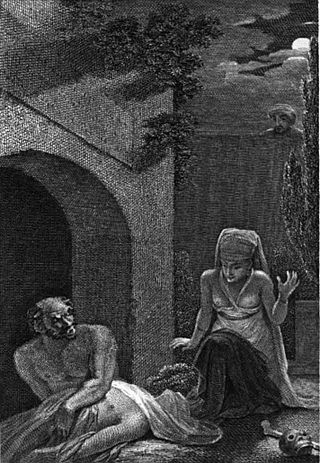
A ghoul is a demon-like being or monstrous humanoid. The concept originated in pre-Islamic Arabian religion, associated with graveyards and the consumption of human flesh. Modern fiction often uses the term to label a certain kind of monster.

An ogre is a legendary monster depicted as a large, hideous, man-like being that eats ordinary human beings, especially infants and children. Ogres frequently feature in mythology, folklore, and fiction throughout the world. They appear in many classic works of literature, and are most often associated in fairy tales and legend.
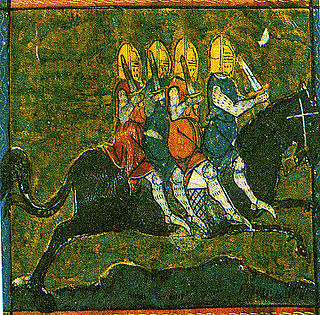
Bayard is a magic bay horse in the legends derived from the medieval chansons de geste. These texts, especially that of The Four Sons of Aymon, attribute to him magical qualities and a supernatural origin. He is known for his strength and intelligence, and possesses the supernatural ability to adjust his size to his riders.

Anchamps is a commune in the Ardennes department in the Grand Est region of northern France.
Mythic humanoids are legendary, folkloric, or mythological creatures that are part human, or that resemble humans through appearance or character. Each culture has different mythical creatures that come from many different origins, and many of these creatures are humanoids. They are often able to talk and in many stories they guide the hero on their journey.

Bogny-sur-Meuse is a commune in the Ardennes department in the Grand Est region of northern France. Bogny-sur-Meuse is known for multiple sites linked to the medieval legend of The Four Sons of Aymon, such as the Hermitage, the statue of Bayard the horse, and the four peaks symbolizing the four brothers. Situated in the Ardennes mountains, the commune extends along the banks of the Meuse.
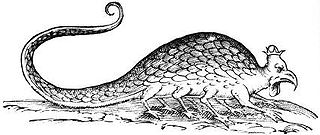
In European bestiaries and legends, a basilisk is a legendary reptile reputed to be a serpent king, who causes death to those who look into its eyes. According to the Naturalis Historia of Pliny the Elder, the basilisk of Cyrene is a small snake, "being not more than twelve inches in length", that is so venomous, it leaves a wide trail of deadly venom in its wake, and its gaze is likewise lethal.
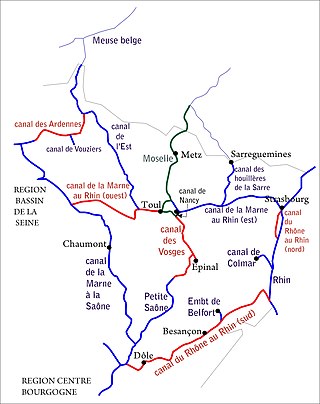
The Canal de la Meuse is the current name of what used to be the northern branch of the Canal de l'Est. It is a canal in northeastern France, predominantly made up of the canalised river Meuse. The Canal de l'Est was built from 1874 to 1887 to provide a waterway inside the new border with Prussia after the Franco-Prussian War, Overall, the canal had a total length of 394 kilometres (245 mi). In 2003, the northern and southern branches were officially renamed Canal de la Meuse and Canal des Vosges respectively.

The Four Sons of Aymon, sometimes also referred to as Renaud de Montauban is a medieval tale spun around the four sons of Duke Aymon: the knight Renaud de Montauban, his brothers Guichard, Allard and Richardet, their magical horse Bayard, their adventures and revolt against the emperor Charlemagne. The story had a European success and echoes of the story are still found today in certain folklore traditions.
The Cheval Mallet describes a fabulous and evil horse mentioned in folklore around the French Vendée, Poitou, and more frequently in the Pays de Retz, near Lac de Grand Lieu. It was supposed to appear at night or in the middle of the night as a beautiful white or black horse, saddled and bridled, and tempt travelers exhausted by a long journey. Several legends about the unwary who rode this horse, and never returned unless you have them on the price of travel or protection spell as a medal of St. Benedict. A feast was also known as horse Merlette, Merlet or Mallet in the town of Saint-Lumine-de-Coutais, it had a military function, cathartic celebration of renewal or carnival, and featured several actors around one oak, one disguised as a horse. It was opposed by the ecclesiastical authorities and banned in 1791.

Pierre Dubois, is a French specialist in enchantement. He is an author, Franco-Belgian comics scriptwriter, storyteller and lecturer at the origin of renewed interest in fairies and little people in France. He became fascinated at a young age with fairy tales and Fairytale fantasy, becoming an illustrator after a short study of Fine Arts. He has brought together local legends and recreated them in radio and television shows for over thirty years. He is the inventor of elficology (elficologie) as a name for the study of the "little people", although it was originally just a joke on his part. His first comic book was published in 1986. Since then he has produced one each year and also made regular appearances on television and at conferences, always in the area of fairy tales, dreams and legends related to the fairies.
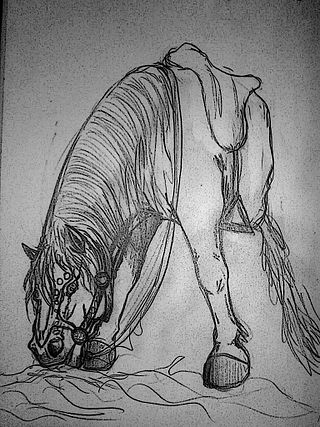
The Cheval Gauvin is a legendary evil horse of Franche-Comté, France and the Jura Mountains in Switzerland. It is said to wander along watercourses, through forests and graveyards, and to attempt to kill those who ride it, either by drowning them or throwing them into an abyss.
Émile Nourry was a French publisher, bookseller, and folklorist known under the pen name Pierre Saintyves.
Paul Alfred Delarue, born 20 April 1889 in Saint-Didier, Nièvre, died 25 July 1956 in Autun, Saône-et-Loire, was a French folklorist.

A groac'h is a kind of Breton water-fairy. Seen in various forms, often by night, many are old, similar to ogres and witches, sometimes with walrus teeth. Supposed to live in caverns, under the beach and under the sea, the groac'h has power over the forces of nature and can change its shape. It is mainly known as a malevolent figure, largely because of Émile Souvestre's story La Groac'h de l'île du Lok, in which the fairy seduces men, changes them into fish and serves them as meals to her guests, on one of the Glénan Islands. Other tales present them as old solitary fairies who can overwhelm with gifts the humans who visit them.
Morvarc'h is the name of a fabulous horse of Breton legend found in two folktales reworked in the 19th and 20th centuries. Though its name appears in older sources, it was invented or reinterpreted by Charles Guyot, who named it Morvark in his version of the legend of the city of Ys in 1926. It belongs to the "Queen of the North" Malgven, who gives it to her husband King Gradlon. Endowed with the ability to gallop on the waves, Morvarc'h is described as having a black coat and as breathing flames through its nostrils. It also appears in a Breton folktale about King Marc'h of Cornouaille. In the course of a deer hunt it is killed by its own rider's arrow, which has been turned around by the spell of Dahud, the daughter of Malgven. She then puts the ears of the horse Morvarc'h on the head of King Marc'h, who seeks in vain to hide them.

Lou Drapé is a legendary folkloric horse of the town of Aigues-Mortes in the Gard region, in the Petite Camargue marsh area of France. It is said to wander around the walls of the city at night and to take a large number of children on his back to abduct them. These children never return from this journey.
Les Princes et la Princesse de Marinca is a French-Canadian fairy tale from Gaspésie published by Canadian folklorist Carmen Roy. It is related to the motif of the calumniated wife and classified in the international Aarne-Thompson-Uther Index as type ATU 707, "The Three Golden Children".
References
- ↑ Meyrac, Albert (1966). Traditions, coutumes, légendes et contes des Ardennes comparés avec les traditions, légendes et contes de divers pays ... (in French). Éditions F.E.R.N. p. 353.
- 1 2 3 4 Delmas, Marie-Charlotte (1 June 2017). Dictionnaire de la France merveilleuse (in French). Place des éditeurs. p. 477. ISBN 978-2-258-13660-1.
- 1 2 3 4 5 Seignolle, Claude (12 November 2015). Contes, récits et légendes des pays de France, Volume 2 (in French). Place des éditeurs. p. 409. ISBN 978-2-258-13491-1.
- ↑ Méchin, Christophe (2017). Dictionnaire des légendes d'Ardenne (in French). p. 144. ISBN 978-2-915764-03-1.